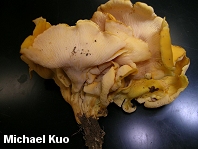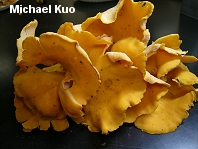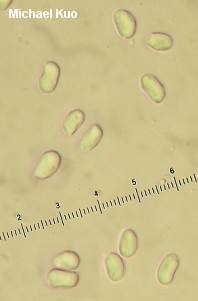| Major Groups > Chanterelles and Trumpets > Cantharellus confluens |

|
Cantharellus confluens [ Basidiomycota > Cantharellales > Cantharellaceae > Cantharellus . . . ] by Michael Kuo If you want to tell me this species is dubiously separated from Cantharellus lateritius, I won't argue with you--much. Virtually the only feature distinguishing the two species is the fact that in Cantharellus confluens, as the name suggests, the mushrooms are often confluent; stems give rise to more than one cap-like structure. In Cantharellus lateritius this does not usually happen. Both species have a smooth to wrinkled undersurface, and microscopic features are virtually identical. To my knowledge no DNA study has been published in which Cantharellus confluens is considered. Description: Ecology: Mycorrhizal with hardwoods; growing alone, scattered, or gregariously; summer; southern Appalachians, southeastern United States, and Mexico. The illustrated and described collection is from Ohio.Fruiting Body: Up to 10 cm high and 8 cm across; usually with two to several cap-like structures arising from one or more individual or conjoined stem structures. Individual Caps: Flat, becoming centrally depressed but without developing a perforated disc; fleshy; bald or nearly so; dry; orangish yellow; the margin fairly thick, becoming wavy to lobed or irregular. Undersurface: Running down the stem; smooth or with shallow wrinkles or, near the margin, somewhat veined; colored like the cap or paler; bruising and staining dark yellow. Stem: Up to 4 cm long and 2.5 cm thick; tapering to the base; dry; colored like the cap or paler; fleshy (not hollow); bruising and staining dark yellow. Flesh: Whitish; soft; unchanging when sliced. Odor and Taste: Taste not distinctive; odor fragrant and sweet. Spore Print: Pale yellow. Microscopic Features: Spores 7-9 x 4-5 µ; ellipsoid; smooth; inamyloid; ochraceous in KOH; often uniguttulate. Basidia to about REFERENCES: (Berkeley & Curtis, 1866) Petersen, 1979. (Saccardo, 1888; Smith, 1968 [as lateritius?]; Petersen, 1979b; Weber & Smith, 1985.) Herb. Kuo 07171005. This site contains no information about the edibility or toxicity of mushrooms. |
© MushroomExpert.Com |
|
Cite this page as: Kuo, M. (2015, February). Cantharellus confluens. Retrieved from the MushroomExpert.Com Web site: http://www.mushroomexpert.com/cantharellus_confluens.html |


